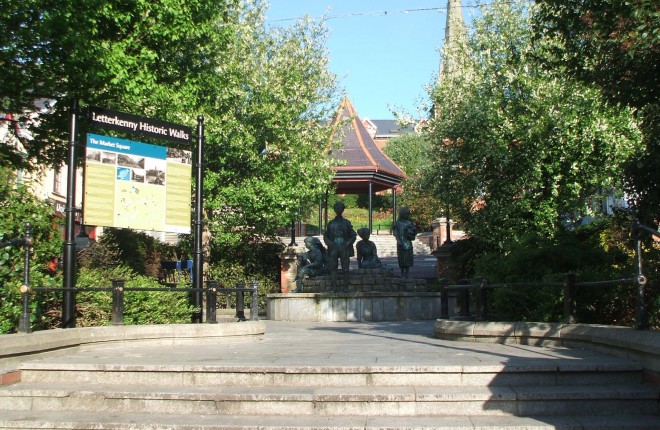
Market Square, Letterkenny.
THE latest survey by the Irish Business Against Litter (IBAL) alliance shows Letterkenny is Clean to European Norms, in 27th position in the ranking of 40 towns and cities nationwide, slipping from position of 11th last year, when it was deemed “Cleaner than European Norms”.
The survey showed another improvement in cleanliness levels overall, with 75 per cent of areas as least as Clean as European Norms. Killarney was judged the cleanest town, followed by Dungarvan and Tralee. Connecting roads between 34 towns were assessed and found to be less littered than last year.
For Letterkenny, the An Taisce report stated: “Half of the sites surveyed in Letterkenny got the top litter grade, four were moderately littered and one was seriously littered – the latter was the residential area of Fortwell. Some of the top ranking sites included Car Park at Letterkenny Retail Park, Letterkenny Bus Station and Tourist Information and Environs – these sites were not just clear of litter but well presented and maintained.”
For the first time, no towns in Ireland were branded as ‘blackspots’ or ‘seriously littered’. “The most striking aspect of this survey is the improvement in neglected urban areas such as Dublin’s North Inner City and Cork’s Farranree,” says Conor Horgan of IBAL. Both areas have improved from ‘litter blackspot’ to ‘littered’ status this time round.
While tourist towns like Killarney, Tralee and Kilkenny performed well, visitors to Dublin City Centre encountered more litter than previously, with even high footfall areas such as Grafton Street and O’Connell Street slipping to “moderately littered”. The An Taisce report slammed the Manor Street /Brunswick Street/Church Street area as “a litter blackspot, as was a site on Capel Street.”
“The great majority of tourist towns again showed their best side to tourists this summer,“ comments Horgan. “Unfortunately, for Ireland to project a clean image, we need our Capital City to be free of litter, and this year we are seeing a deterioration in cleanliness levels in Dublin City Centre, and indeed several roads around Dublin Airport, where most of our visitors enter the country.”
The survey, carried out by An Taisce on behalf of IBAL, showed sweet papers, cigarette butts, fast food wrappers and chewing gum were the most common forms of litter. Dog fouling, while not as prevalent, continues to be a source of public concern, according to IBAL. “Where special bins are used to collect dog waste, they need to be emptied in tandem with demand. Otherwise they become unhygienic eyesores, as is the case with many recycling facilities,” says Horgan.
1 in 10 shopping centres were litter blackspots. “It is not always easy to identify where responsibility lies for littered sites in a town, but in the case of shopping centre car parks the local authority just needs to enforce the law with the landowner,” says Horgan. “Until we see more prosecutions of this nature there will be no real deterrent for offenders.”









